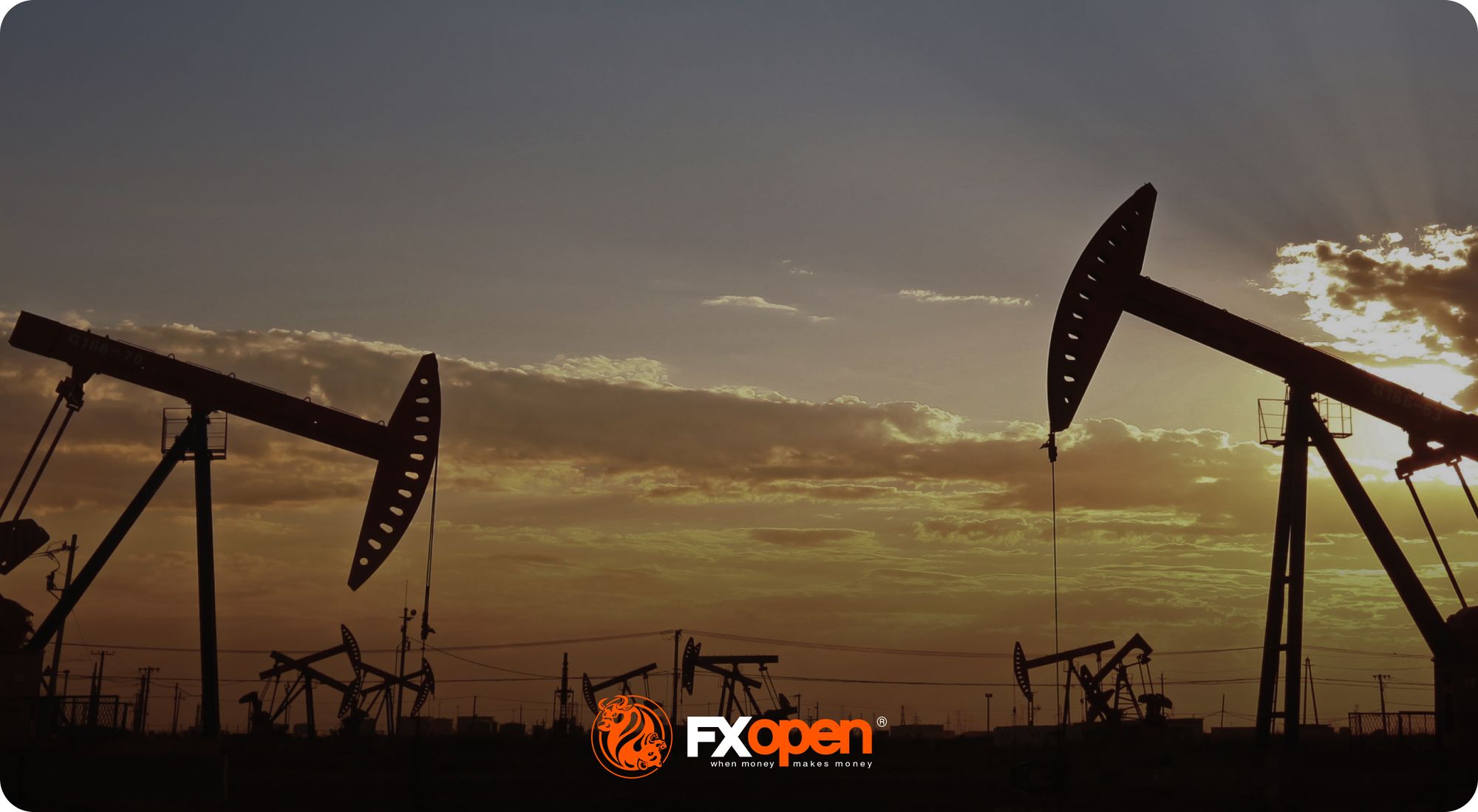How Can You Trade Energy Commodities?

Energy trading connects global markets to the vital resources that power economiesoil and natural gas. These commodities arent just essential for industries and homes; theyre also dynamic assets for traders, influenced by geopolitics, supply, and demand.
Whether youre exploring benchmarks like Brent Crude and WTI or understanding natural gas markets, this article unpacks the essentials of energy commodities and how to trade them.
What Is Energy Trading?
Energy trading involves buying and selling energy resources that power industries and households worldwide. These commodities are essential for modern life and are traded in global markets both as physical products and financial instruments.
Energy commodities include resources like oil, natural gas, gasoline, coal, ethanol, uranium, and more. In this article, well focus on the two that traders interact with the most: oil and natural gas.
Oil is often divided into benchmarks like Brent Crude and WTI, which set global and regional pricing standards. These benchmarks represent crude oil that varies in quality and origin, impacting its trade and refining applications.
Natural gas, on the other hand, plays a critical role in electricity generation, heating, and industrial processes. Its traded in various forms, including pipeline gas and liquefied natural gas (LNG), offering flexibility in transportation and supply.
What makes energy commodities unique is their global demand and sensitivity to external factors. Weather patterns, geopolitical developments, and economic activity all heavily influence their prices. For traders, this creates a dynamic market with potential opportunities to take advantage of price movements.
Additionally, energy commodities can act as economic indicators. A surge in oil prices, for example, might reflect growing demand from expanding industries, while a drop could indicate reduced consumption. Understanding these resources isnt just about their practical useits about grasping their role in shaping global markets and financial systems.
Oil: Brent Crude vs WTI
Brent Crude and WTI (West Texas Intermediate) are the worlds two leading oil benchmarks, shaping prices for a resource critical to industries and economies. Despite both being types of crude oil, they differ significantly in origin, quality, and market influence.
Brent Crude
Brent Crude is a globally recognised benchmark for oil pricing, primarily sourced from fields in the North Sea. Its importance lies in its role as a pricing reference for about two-thirds of the worlds oil supply. What makes Brent unique is its lighter and sweeter quality, meaning it has lower sulphur content and is easier to refine into fuels like petrol and diesel.
This benchmark is particularly significant in European, African, and Asian markets, where it serves as a key indicator of global oil prices. Its value is heavily influenced by international demand, geopolitical events, and production levels in major exporting countries. For traders, Brent offers a window into global supply and demand trends, making it a critical component of energy markets.
West Texas Intermediate (WTI)
WTI, or West Texas Intermediate, is the benchmark for oil produced in the United States. Extracted primarily from Texas and surrounding regions, WTI is even lighter and sweeter than Brent, making it suitable for refining into high-value products like petrol.
WTIs pricing is heavily tied to North American markets, with its hub in Cushing, Oklahoma, a key point for storage and distribution. Localised factors, like US production rates and storage capacity, often create price differentials between WTI and Brent, with Brent typically trading at a premium. For example, logistical bottlenecks in the US can drive WTI prices lower.
The main distinction between the two lies in their geographical focus: while Brent captures the international markets pulse, WTI provides insights into North American energy dynamics. Together, they form the foundation of global oil pricing.
Natural Gas: A Growing Energy Commodity
Natural gas is a cornerstone of the global energy market, valued for its versatility and role in powering economies. Its used extensively for electricity generation, heating, and industrial processes, with demand continuing to rise as countries seek cleaner alternatives to coal and oil.
This energy commodity comes in two primary forms for trade: pipeline natural gas and liquefied natural gas (LNG). Pipeline gas is delivered directly via extensive networks, making it dominant in regions like North America and Europe.
LNG, on the other hand, is supercooled to a liquid state for transportation across oceans, opening up markets that lack pipeline infrastructure. LNG trade has grown rapidly in recent years, with key suppliers like Qatar, Australia, and the US meeting surging demand in Asia.
Pricing for natural gas varies regionally, with hubs like Henry Hub in the US and the National Balancing Point (NBP) in the UK serving as benchmarks. These hubs reflect regional dynamics, such as weather conditions, storage levels, and local supply disruptions.
Natural gas prices are also closely tied to broader geopolitical and economic factors. For example, harsh winters often drive up heating demand, while conflicts or sanctions affecting major producers can create supply constraints. This volatility makes natural gas an active and highly watched market for traders, offering potential opportunities tied to shifting global conditions.
Price Factors of Energy Commodities
Energy commodity prices are influenced by a mix of global events, market fundamentals, and local factors. Heres a breakdown of key elements driving oil and gas trading prices:
- Supply and Production Levels: Output from major producers like OPEC nations, the US, and Russia has a direct impact on prices. Supply cuts or surges can quickly move markets.
- Geopolitical Events: Conflicts, sanctions, or political instability in oil and gas-rich regions often disrupt supply chains, creating volatility.
- Weather and Seasonal Demand: Cold winters boost natural gas demand for heating, while summer driving seasons often increase oil consumption. Extreme weather events, such as hurricanes, can also damage infrastructure and reduce supply.
- Economic Growth: Expanding economies typically consume more energy, driving demand and prices higher. Conversely, a slowdown or recession can weaken demand.
- Storage Levels: Inventories act as a cushion against supply disruptions. Low storage levels often signal tighter markets, pushing prices up.
- Transportation Costs: The cost of shipping oil or LNG across regions impacts pricing, particularly for seaborne commodities like Brent Crude and LNG.
- Exchange Rates: Energy commodities are usually priced in dollars, meaning currency fluctuations can affect affordability in non-dollar markets.
- Market Sentiment: Traders expectations, shaped by reports like US inventory data or OPEC forecasts, can influence short-term price movements.
How to Trade Energy Commodities
Trading energy commodities like oil and natural gas involves navigating dynamic markets with the right tools, strategies, and risk awareness. Heres a breakdown of how traders typically approach energy commodity trading:
Instruments for Energy Trading
Energy commodities can be traded through various instruments, typically through an oil and gas trading platform. For instance, FXOpens TickTrader platform provides access to oil and gas CFDs alongside 700+ other markets, including currency pairs, stocks, ETFs, and more.
- CFDs (Contracts for Difference): Popular among retail traders because they allow access to global energy markets without owning the physical assets. They offer leverage and provide flexibility to take advantage of both rising and falling prices. Additionally, CFDs have lower entry costs, no expiration dates, and eliminate concerns like storage or delivery logistics. Please remember that leverage trading increases risks.
- ETFs (Exchange-Traded Funds): Energy ETFs diversify exposure to energy commodities or related sectors.
- Energy Stocks: Shares in oil and gas companies provide indirect exposure to commodity price changes.
- Futures and Options: These are contracts to buy or sell commodities at a future date. While they provide leverage and flexibility, trading energy derivatives like futures and options is often unnecessarily complex for the average retail trader. Futures require managing expirations, and options involve understanding advanced pricing models.
Analysis: Fundamental and Technical
Energy traders rely on two primary types of analysis:
- Fundamental Analysis: Examines supply and demand factors like OPEC decisions, weather patterns, geopolitical tensions, and economic indicators such as GDP growth or industrial output.
- Technical Analysis: Focuses on price charts, identifying patterns, trends, and important levels to anticipate potential market movements.
Combining these approaches can offer a broader perspective, helping traders refine their strategies.
Taking a Position and Managing Risk
Once traders identify potential opportunities, they decide on position size and duration based on their analysis. Risk management is critical to help traders potentially mitigate losses in these volatile markets. Strategies often include:
- Diversifying positions to reduce exposure to a single commodity.
- Setting limits on position sizes to align with overall portfolio risk.
- Monitoring leverage carefully, as it can amplify both potential returns and losses.
Risk Factors in Energy Commodities Trading
Trading energy commodities like oil and natural gas offer potential opportunities, but it also comes with significant risks due to the market's volatility and global nature.
- Price Volatility: Energy markets are highly sensitive to geopolitical events, economic shifts, and supply disruptions. This can lead to rapid price swings, particularly if the event is unexpected.
- Leverage Risks: Many instruments, like CFDs and futures, allow traders to use leverage, amplifying both potential returns and losses. Mismanaging leverage can lead to significant setbacks.
- Geopolitical Uncertainty: Events like conflicts in oil-producing regions or trade sanctions can disrupt supply chains and sharply impact prices.
- Market Sentiment: Energy prices can react strongly to reports like inventory data, OPEC announcements, or unexpected news, creating rapid shifts in sentiment and price direction.
- Overexposure: Focusing too heavily on a single energy commodity can magnify losses if the market moves against the position.
- Economic Factors: Slowing industrial activity or recession fears can reduce demand for energy, putting downward pressure on prices.
The Bottom Line
Energy commodities trading offers potential opportunities, driven by global demand and supply. Whether focusing on oil, natural gas, or other energy assets, understanding the fundamentals and risks is key to navigating this complex market. Ready to explore oil and gas commodity trading via CFDs? Open an FXOpen account to access advanced tools, competitive spreads, low commissions, and four trading platforms designed to support your journey.
FAQ
What Are Energy Commodities?
Energy commodities are natural resources used to power industries, homes, and transportation. Key examples include crude oil, natural gas, and coal. These commodities are traded globally as physical assets or through financial instruments like futures and CFDs.
Can I Make Money Trading Commodities?
Trading commodities offers potential opportunities to take advantage of price movements, but it also involves significant risks. The effectiveness of your trades depends on understanding of market dynamics, analyses of supply and demand, and risk management. While some traders achieve returns, losses are also common, especially in volatile markets like energy.
How Do I Start Investing in Energy?
Investing in energy typically begins with choosing an instrument like ETFs or stocks, depending on your goals and risk tolerance. Researching market fundamentals, monitoring geopolitical and economic factors, and practising sound risk management are essential steps for new investors.
What Is an Energy Trading Platform?
An energy trading platform, or power trading platform, is software that enables traders to buy and sell energy commodities. These energy trading solutions provide access to pricing data, charting tools, and news feeds, helping traders analyse markets and execute trades efficiently.
Read more: https://fxopen.com/blog/en/how-can-you-trade-energy-commodities/
Text source: Forex Trading Blog










